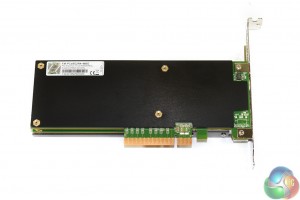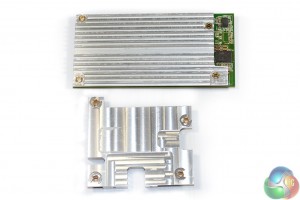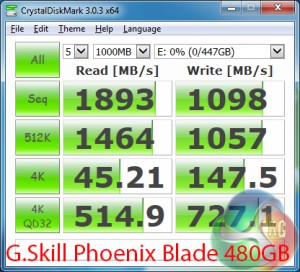
Everybody loves speed, and there's no easier way to enhance the snappiness of general usage tasks than by using a solid state drive. But the primary storage interface – SATA 6Gbps – saw its speed limit reached by fast SSD's more than two years ago. If you wanted higher performance, multiple SATA drives in RAID or a dedicated PCIe solution were the ways to go. In its 480GB Phoenix Blade, G.Skill has opted to provide both; there's a four-controller RAID 0 configuration for high speed numbers and a PCIe 2.0 x8 interface for ample bandwidth allocation.
While that opening statement is largely correct for recent years, the introduction of the faster-than-6Gbps M.2 and SATA Express interfaces has changed things over the past few months. Almost all motherboards sporting Intel's 9-series chipset now feature M.2 and/or SATA Express connections that provide between 10 and 32Gbps transfer rates.
That's great for new buyers, but not so much for users with older motherboards who still want the benefits of high-speed storage. And let's not even get started on the scarcity of SATA Express drives or M.2 devices that actually warrant high-speed PCIe lanes.
Here is where the venerable PCIe connection makes a resurgence for G.Skill's Phoenix Blade SSD. Combining four of LSI SandForce's tried-and-tested SF-2281 controllers in RAID 0 with 480 usable gigabytes of 19nm Toshiba MLC NAND, G.Skill is able to quote up to 2000MBps read and write speeds for the Phoenix Blade. That's about four times faster than the SATA 6Gbps connection's top limit and outlines why a 4GBps (per direction) PCIe 2.0 x8 connection is deemed necessary.
Can G.Skill's Phoenix Blade outline the performance benefits of four SandForce controllers in RAID 0? Or do we have a case of ‘too many cooks spoil the broth'?
Specification:
- Capacity: 480GB
- Interface: PCI-Express 2.0 x8
- Form Factor: Half Height
- Memory Components: MLC
- Dimensions: 170mm x 70mm x 21mm (Net)
- Weight: 275g (Net)
- Max Read Speed: 2000 MB/s (Iometer)
- Max Write Speed: 2000 MB/s (Iometer)
- Sequential Read: 1900 MB/s (CrystalDiskMark)
- Sequential Write: 1050 MB/s (CrystalDiskMark)
- 4KB Random Read: Up to 90,000 IOPS (Iometer)
- 4KB Random Write: Up to 245,000 IOPS (Iometer)
- MTBF: 1,000,000 Hours
- Power Consumption (Active): Max Read Workload: 15W / Max Write Workload: 18W
- Power Consumption (Idle): 8W
- Operating Temperature: 0°C ~ 55°C
G.Skill ships the Phoenix Blade in a sturdy black box. A graphic which is similar to Corsair's new (and seemingly detested) gaming logo occupies the front side. A table of specifications in present on the rear.
An additional bracket is supplied, allowing the drive to be used in a chassis with half-height PCIe expansion slots. The driver CD contains the software required to use the drive and to install Windows onto it.
The official directions for installing Windows on the Phoenix Blade are as follows:
- Insert Windows installation CD/DVD into disc drive
- When prompted to install third-party SCSI or RAID driver, press the “F6” key, then press “S” for “Specified Additional Device”.
- Insert driver disc (or USB flash drive with drivers copied from the [Windows Pre-Install Drivers] folder) and follow on-screen instructions to complete driver and Windows installation.
Provided you have means of getting the SSD drivers onto your system while its disc drive (if you choose the DVD installation route) is in use, loading Windows should be straightforward.
An attractive red and black theme is predominant all over the Phoenix Blade. G.Skill adds its company logo and a graphic for the product.
Ventilation holes allow the controllers and flash chips to release their heat into one's chassis. Lifetime management is handled in the form of TRIM and UNMAP. There's also S.M.A.R.T support for monitoring purposes. And when that's not enough, there's a 3-year warranty provided as backup.
A very smart design decision by G.Skill was to utilise a black backplate. This sheet of metal not only acts as a heatsink for eight NAND chips and two SandForce controllers, it also disguises a significant proportion of the drive's ugly green PCB.
The PCIe 2.0 x8 connector is clearly visible. To get the best performance out of the drive, you will want to install it in a PCIe 2.0 (or 3.0) slot with at least eight lanes being fed. On Intel 7-, 8- or 9-series boards, for example, this may negate the functionality of SLI for graphics cards, due to the processor's sixteen lane limitation.
Two activity LEDs are visible through a cut-out in the ventilated PCI bracket.
G.Skill only ships the Phoenix Blade in a 480GB capacity version. We would have liked to see a 240GB variant for speed enthusiasts with lower storage requirements.
32 of Toshiba's 19nm, 128Gbit MLC NAND chips (part number: TH58TEG7DDKTA20) combine to form the permanent storage. That 512GB worth of NAND is then shrunk to the 480GB usable capacity due to over-provisioning. Two Altera EN6360QI PowerSoC aid power delivery.
TRIM support and communications between the four SATA-based SF-2281 controllers and the PCIe x8 slot are handled by a SBC208-2 chip. The use of SATA-based controllers means that the drive operates via the common AHCI standard.
According to G.Skill, 4KB random read can deliver up to 90,000 IOPS, while 4KB random write is up to a blistering 245,000 IOPS.
Consuming up to 15W for a read workload, or 18W when writing, it is no surprise that a large emphasis is placed on drive cooling.
The RAID controller's easily detachable heatsink makes very poor contact with the actual surface of the chip. This is a quality issue that G.Skill needs to address in future shipments.
G.Skill splits the four SF-2281 controllers into two pairs and then allocates them a specific heatsink and the rear backplate for their cooling needs. Both NAND-only PCB faces are left to rely upon passive cooling.
The Phoenix Blade sits nicely below a graphics card in a system. Some form of side-mounted covering plate with an attractive design would have been welcomed.
We test the G.Skill Phoenix Blade SSD while it is installed in a dedicated PCIe 3.0 x8 slot on our Asus X99 Deluxe motherboard.
This configuration ensures that bandwidth bottlenecks are eliminated.
Testing is performed with an empty drive in order to challenge G.Skill's maximum performance claims.
G.Skill includes a Windows software tool that allows users to restore their drive performance, update the firmware, and view device information. There is also a Windows driver to install when using the drive.
When booting into Windows, there is a delay of approximately five seconds while the Phoenix Blade initialises. This is one of the drawbacks of using a third-party chipset to link the drive's controllers to the physical interface.
Test System:
- Processor: Intel Core i7 5960X ES.
- Memory: 16GB (4x 4GB) G.Skill Ripjaws4 2666MHz CL15 DDR4 @ 1.20V.
- Motherboard: Asus X99 Deluxe.
- Graphics Card: Asus R9 280X Matrix Platinum 3GB.
- System Drive: 500GB Samsung 840.
- CPU Cooler: Corsair H100i.
- Case: NZXT Phantom 630.
- Power Supply: Seasonic Platinum 1000W.
- Operating System: Windows 7 Professional with SP1 64-bit.
Compared SSDs:
- OCZ RevoDrive 350 480GB (PCIe).
- Plextor M6e 512GB (PCIe M.2).
- Samsung 840 EVO 1TB (SATA 6Gbps).
- ADATA SP610 512GB (SATA 6Gbps).
The above drives were evaluated in a different test system to the one used today. All tests are entirely storage-related therefore test system differences are unlikely to cause any discrepancies.
Tests:
- AS SSD.
- ATTO.
- CrystalDiskMark.
- IOMeter.
CrystalDiskMark is a useful benchmark to measure theoretical performance levels of hard drives and SSDs. We are using V3.0.3.
CrystalDiskMark shows the sequential performance numbers hitting (or even surpassing) G.Skill's claimed levels of 1,900MBps read and 1,050MBps write.
4K QD32 performance is not quite as high as that shown by the OCZ RevoDrive 350. Tweaks to the OCZ firmware may be to thank for the slightly better result in that specific test.
It's worth noting that performance does tend towards a reduction, as the number of total benchmark runs increases. This implies that the blocks aren't able to be written to as quickly as when they have previously held data (which is where TRIM comes in handy).
Certain results with incompressible data in CrystalDiskMark are pushing the 2,000MBps-maximum that G.Skill claimed. It's the write performance that truly benefits from the ability to compress data on-the-fly.
The ATTO Disk Benchmark performance measurement tool is compatible with Microsoft Windows. Measure your storage systems performance with various transfer sizes and test lengths for reads and writes. Several options are available to customize your performance measurement including queue depth, overlapped I/O and even a comparison mode with the option to run continuously. Use ATTO Disk Benchmark to test any manufacturer's RAID controllers, storage controllers, host adapters, hard drives and SSD drives and notice that ATTO products will consistently provide the highest level of performance to your storage.
Excellent performance numbers are shown in the ATTO benchmark. G.Skill's Phoenix Blade is able to outperform all competing options in ATTO's workload, managing to break the 2,000MBps read speed barrier in the process.
AS SSD is a great free tool designed just for benching Solid State Drives. It performs an array of sequential read and write tests, as well as random read and write tests with sequential access times over a portion of the drive. AS SSD includes a sub suite of benchmarks with various file pattern algorithms but this is difficult in trying to judge accurate performance figures.
The excellent level of performance offered by G.Skill's quad RAID 0 solution continues in the AS SSD benchmark. Not even OCZ's similar RevoDrive 350 can keep up with the well-tuned firmware deployed alongside the G.Skill hardware.
Sequential performance is particularly impressive and falls pretty much in line with G.Skill's 1,900MBps read and 1,050MBps write claims.
IOMeter is another open source synthetic benchmarking tool which is able to simulate the various loads placed on hard drive and solid state drive technology.
IOMeter tells a tale of the usage scenario for G.Skill's Phoenix Blade SSD.
4KB random read IOPS are competitive with the market leaders using the SATA 6Gbps interface, however G.Skill's PCIe-based SSD is no better than Samsung's 840 EVO 1TB when performing random read tasks on 4KB files. And that's an important factor for consumers, as 4KB random read performance is considered important for general usage in the Windows operating system.
Looking at the 4KB random write performance, however, shows the G.Skill Phoenix Blade delivering blistering performance that cannot be matched, or even neared, by a SATA 6Gbps drive. 180,000 IOPS is about twice the level of what the fastest SATA 6Gbps SSD will provide.
So for users with write-intensive tasks (database management, for example), the Phoenix Blade should provide a worthwhile speed boost over SATA-based alternatives. Consumers interested in random write performance may not be as pleased by G.Skill's PCIe SSD.
The G.Skill Phoenix Blade is a bold move by the Taiwanese company, and one that is done with the intention of reclaiming its place amongst the elite high-performance SSD vendors. Highly competitive performance and a solid design, are how G.Skill has managed to send its Phoenix Blade to compete right at the top of the consumer SSD food chain.
Performance of the four SF-2281 controllers in RAID 0, and Toshiba 19nm MLC NAND, is excellent. The all-important 4KB random read test delivers almost 85,000 IOPS in IOMeter, which is not significantly faster than one of the leading SATA 6Gbps drives. However, 4KB random write performance stands at a highly-impressive 180,000 IOPS, making the drive ideal for users with write-intensive operations.
Sequential performance is impressive too, with 1,900MBps reads and 1,050MBps writes being shown off in AS SSD. And let's not forget the almost-2GBps maximum read/write performance shown by ATTO.
Build quality of the Phoenix Blade is excellent. A solid aluminium heatsink and multi-PCB design keeps the drive adequately cooled throughout its operation. The black and red styling is another aspect that will appeal to gamers and enthusiast interested in attractive systems.

Available for £549.98 from OverclockersUK, the G.Skill Phoenix Blade is actually one of the most affordable PCIe SSDs in its performance class. However, price competition is strong from the likes of Plextor's PCIe-fed M6e (despite being a lower performer) and multiple SATA 6Gbps SSDs in a manual RAID 0 array.
If you're looking for an elegant single-drive solution that meets your demanding workloads (especially regarding write-intensive tasks), G.Skill's Phoenix Blade 480GB PCIe SSD is an excellent choice. The flagship drive offers blisteringly-fast write performance with generally positive read numbers, and it does so while consistently outperforming the competition.
Discuss on our Facebook page, over HERE.
Pros:
- Excellent sequential performance.
- Strong random write performance.
- Good build quality and design.
- Installation flexibility (half-height form factor).
- Good software tools (can restore drive performance and boot Windows).
Cons:
- Very expensive compared to multiple SATA drives and Plextor M6e.
- 4KB random read performance only comparable to current flagship SATA 6Gbps SSDs.
- 480GB capacity only – 240GB would be welcomed.
KitGuru says: With performance that puts it amongst the fastest consumer SSDs available, the Phoenix Blade is an excellent return to the high-end SSD market for G.Skill.
 KitGuru KitGuru.net – Tech News | Hardware News | Hardware Reviews | IOS | Mobile | Gaming | Graphics Cards
KitGuru KitGuru.net – Tech News | Hardware News | Hardware Reviews | IOS | Mobile | Gaming | Graphics Cards































but that price tho. I rather buy a car
Will wait for Black Friday 2015
A £500 car??? You can’t get a decent push bike for £500 never mind a car!